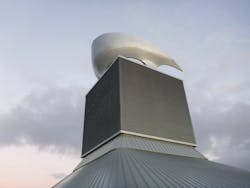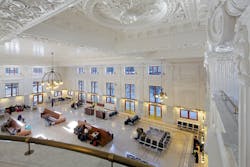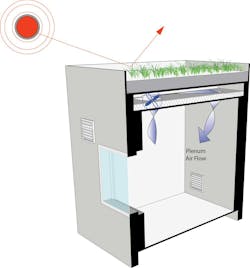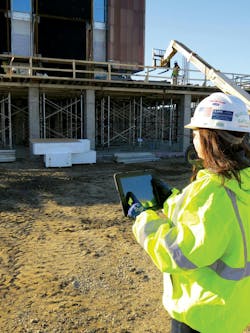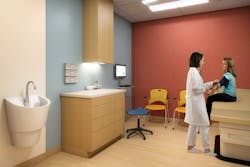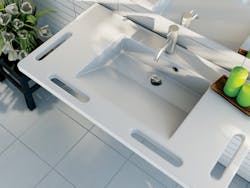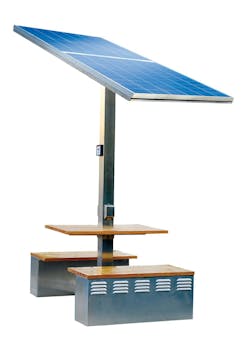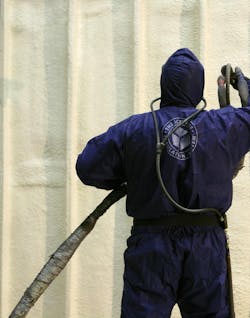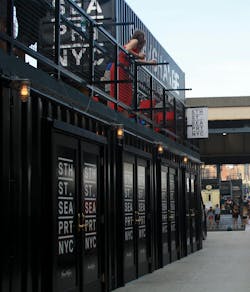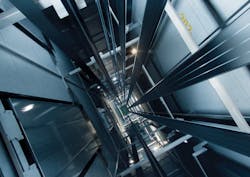16 great solutions for architects, engineers, and contractors
From a crowd-funded smart shovel to a why-didn’t-someone-do-this-sooner scheme for managing traffic in public restrooms, these ideas are noteworthy for creative problem-solving. Here are some of the most intriguing innovations the BD+C community has brought to our attention this year.
1. TRUSS SYSTEM UNDERGIRDS MONUMENTAL STAIR
Structure becomes art at a Massachusetts college library
To invite exploration of its new academic library, Salem (Mass.) State University selected a light-filled and airy design. The site and program called for deep floor plates, so the Building Team devised a dramatic open staircase as a central feature to help break up the density.
The engineering solution consists of a truss that supports the whole stair, with each step created from a triangular box beam that hangs off the truss. Stairs are stringer-free and accented with eye-catching red paint. Glass panels protect users while showcasing the design. The prominent feature is also visible from the academic quad to the north. On the Building Team: Shepley Bulfinch (architect), Simpson Gumpertz Heger (SE), and Lee Kennedy Company (GC).
2. ARCHITECTURAL PRIVACY GLASS
Obscuring optic pattern maximizes solitude, daylight
As commercial buildings become more transparent in design, the need for privacy is critical. Building Teams have specified everything from frosted glazing to acrylic panels to glass blocks to provide well-lit yet private spaces for building occupants. Bendheim offers a fresh take on architectural privacy glass with its Houdini Glass. The low-iron, ultra-clear glass features a fine, micro-ribbed surface that lets in maximum daylight while reducing glare and obscuring the shapes of people and objects behind it.
The product can be used in walls, partitions, screens, enclosures, doors, windows, ceilings, and balustrades, in healthcare and educational facilities, laboratories, corporate offices, and retail environments. The glass is nonporous and can withstand daily cleaning and sanitizing with most commercial cleaners. Options include color-coated and mirrored glass.
3. SIGNALS FOR RESTROOM RELIEF
LED lights guide patrons to available stalls
Anyone who’s ever stood in a line at a public restroom, checking beneath doors to see whether stalls are occupied, is likely to applaud the introduction of Tooshlights. The automated system is designed to shorten waiting times, enhance security, and ensure privacy. Wireless technology and sensors trigger LEDs to change from red to green, signaling occupancy or availability. Venue owners can customize light colors to indicate out-of-order units, further improving traffic management.
The manufacturer recommends the system for stadiums, theaters, museums, libraries, residence halls, convention centers, airports, malls, casinos, theme parks, and any facility with large restrooms. The Hollywood Bowl is among the pilot projects.
4. COMPOSITE REFLECTOR CHANNELS THE LIGHT
Super-green Auckland offices topped with distinctive scoop
The new North Wharf headquarters of financial services firm ASB Group, in Auckland, New Zealand, was designed to reduce environmental impact and optimize occupant comfort and safety. The engineering design includes sun and wind power for light and ventilation, with custom architectural sunshades to regulate the daylighting. Topping the building is an unusual curved reflector, made of a composite that incorporates DIAB HP foam with glass and carbon fibers. Yachting Developments manufactured the lightweight unit using techniques more common to the creation of “super yachts.”
Measuring 40x40x6 feet, the reflector, nicknamed the “Helioflek,” helps disperse light through the building and creates a distinctive architectural identity. BVN Donovan Hill in association with Jasmax (architects) and Fletcher Construction led the Building Team for the project, which scored five Green Stars from the New Zealand Green Building Council. Kiwi Income Property Trust was the developer.
5. STEEL REINFORCEMENT REVITALIZES RAIL STATION
Historic Seattle landmark stabilized and renewed
Seattle’s King Street Station, built at the turn of the 20th century, is a major city landmark still in use for Amtrak and commuter train service. The city of Seattle purchased the facility from the Burlington Northern Railroad for $10 in 2008, and a $55 million reconstruction—including remediation of prior unsuccessful remodeling—was completed this year.
To keep all the historic elements in position, 35-foot-high slots were cut into the building’s brick perimeter. Workers then inserted steel columns and high-strength grout alongside existing columns, providing seismic reinforcement and improving the building’s structural capacity. New shear walls were created for the monumental waiting room, and steel floor plates were added on levels two and three for additional strengthening. The hidden techniques met functional objectives but also maintained the historic fabric of the facility, which was required by preservation guidelines.
The Building Team: ZGF Architects; Shiels Obletz Johnsen (owner’s rep); Artifacts Architectural Consulting (historic consultant); ARUP, Rushing (MEP); ARUP, Coughlin Porter Lundeen (SE); KPFF Consulting Engineers (CE); Hart Crowser & Associates (geotechnical/soils consultant); Pivotal Lighting Design, Affiliated Engineers, Eleek Inc. (lighting design); Sparling (acoustics); Performance Contracting Inc., EverGreene Architectural Arts (plaster restoration); and Sellen Construction (contractor).
6. GREEN ROOF DESIGN INNOVATION
Thermal properties harnessed for the next step in vegetated roofs
A team led by Pablo La Roche, Director of Sustainabilty for HMC, has developed a smart green roof that can decouple or couple its thermal mass from the space below, helping with cooling in the summer and heating in the winter. Previous experiments indicate that interior comfort is better in some climates when non-insulated green roofs are combined with night ventilation. However, insulation is needed to block heat during hot days, and to keep heat in when it’s cold outside.
The active green roof system, based on La Roche’s initial work at the Lyle Center for Regenerative Studies at Cal Poly Pomona, includes a plenum below the roof surface. This design provides an air space that allows for convective coupling or uncoupling of the thermal mass with the aid of a fan that runs according to temperature rules. When the system is on, the plenum is ventilated, and the green roof’s mass is combined with the space below. When it is off, the ceiling’s air space acts as additional insulation for the building. Cool air from outdoors can be provided with additional controls and logic rules.
A full-sized version of the system has been integrated in the design of a current project for Irvine (Calif.) Unified School District’s High School No. 5. The concept was recently recognized as one of four national finalists in the MIT Sloan School of Management’s Climate CoLab competition, Building Efficiency category.
7. Put your hands together for this safety practice
Mandatory glove policy keeps construction workers safer
This summer, Clark Construction implemented a new companywide policy requiring workers, including subcontractors’ employees, to wear safety gloves on active job sites. Gloves rated ANSI Level One or EN Level Two are the minimum, with greater levels of protection stipulated for some tasks—a policy stricter than OSHA demands. The Bureau of Labor Statistics reports that a construction worker receives a hand injury every 32 seconds. An accident review revealed that nearly a quarter of all incidents logged by Clark in 2012 involved a hand injury, from bee stings and insect bites to punctures, cuts, and chemical burns. Hand protection joins hard hats, eye protection, and highly visible vests or shirts as mandatory PPE on the company’s job sites. Clark has also implemented strict standards for fall protection and ladder safety (http://bit.ly/17d4RPC).
8. SINK INNOVATIONS FOCUS ON PATIENT SAFETY
These savvy sinks solve common operational issues: wet floors and ADA functionality
Plumbing fixture manufacturers are constantly tweaking their designs for improved performance. In the institutional bathroom sinks category, two recent innovations stand out.
The first, the splash-free ICS System with Selectronic IC Faucet from American Standard, addresses the problem of bathroom splashing that bedevils healthcare providers. Typically, faucets must be placed at least 36 inches from medical dispensing space, making stand-alone sinks a popular option but opening the way to costly slip-and-fall hazards from splashing water. The ICS System all but eliminates splashing with its deep, 26-inch sloped-back basin, side and back splashes, offset drain, goose-necked faucet spout, and sealed overflow to eliminate an area where water can pool.
The second innovation, Pressalit Care’s Matrix line, comes with grab handles built into the sink unit, providing a new dimension of stability and sit-to-stand assistance for people in wheelchairs or those who have balance problems or difficulties in rising. The unit can improve space utilization and potentially reduce costs in bathroom projects by eliminating the need for wall- or floor-mounted grab bars near the sink. The line has four models: Matrix Small, for limited-space bathrooms; Matrix Large, a vanity-size washbasin with handrails integrated into front and both sides (pictured); Matrix Angle, for corner mounting or positioning close to the toilet; and Matrix Curve, for seated users.
9. HYBRID STRUCTURAL SYSTEM FOR MULTIFAMILY APPLICATIONS
Building Team resolves code conundrum with a first-of-its-kind structural solution
When developer and design-builder Opus Group began planning for the Avant at the Arboretum apartment complex in Lisle, Ill., wood-frame construction was the logical choice from a cost perspective for the four-story, 310-unit structure. But when municipality officials informed Opus and the project’s architect, BSB Design, that a local building code amendment required that all exterior walls of multifamily residential buildings incorporate solid masonry construction with a minimum two-hour fire rating, the project was in jeopardy.
The team’s solution was an unusual combination of materials—precast concrete, wood trusses, and metal studs—that satisfied the cost constraints of the project while meeting the local building code. The structural system consists of a 10-inch-thick solid precast panel, 14-inch-tall wood truss, and metal-stud bearing wall. The wood truss spans from the metal bearing wall to a ledger that is anchor bolted to the precast. The apartment units are stacked so that the bearing walls line up from top to bottom.
For mid-rise residential projects, the solution utilizes the best attributes of building materials. Wood is less expensive, but there are more variables to take into account with expansion and shrinkage and compressing over time. Metal and precast do not compress over time but are more expensive. Using precast reduced the amount of shear walls needed throughout the structure, and Opus was able to use the precast walls as firewalls, providing time and cost savings.
10. ERGONOMIC SHOVEL
Designed to cut injury losses
Stephen Walden is the 24-year-old inventor of the Ergonomic Shovel, which is designed to reduce back strain, wrist pain, and shoulder injury among construction laborers. The shovel’s center handle can be rotated, allowing the worker to adjust the hand position to a more comfortable orientation than can be gained using a conventional shovel. This enables a smoother two-handed motion in front of the body, which evenly distributes the load across the shoulders and chest. Walden has raised $64,142 on Kickstarter from 483 backers (exceeding his goal of $45,000) to start Bosse Tools. He is taking orders for spades ($79), flathead shovels, and snow/scoop shovels at http://bossetools.com/order.
11. THE POWER TO CONGREGATE
Solar charging stations double as gathering spots
Nothing like a dying battery to bring people together. That’s the concept behind CarrierClass’s new ConnecTable Solar Charging Stations, which cleverly double as picnic and deck tables to encourage public interaction. Designed for college campuses, office complexes, malls, parks, and sports venues, the tables can be customized for seamless integration into a variety of landscapes. Multiple ConnecTables can be combined to form a micro grid and backup power source during extended power outages.
12. WATER-BLOWN CLOSED-CELL SPRAY FOAM INSULATION
Formulation tames environmental concerns with spray foam
Superior coverage and good insulating properties have made closed-cell spray foam a popular insulation choice among Building Teams. Yet some AEC professionals hesitate to use the technology due to concerns about the ozone-depleting hydrofluorocarbon (HFC) blowing agents used to apply most closed-cell spray foam products.
Spray foam manufacturer Icynene hopes to change that mindset with a new medium-density, closed-cell spray foam insulation that replaces traditional HFC blowing agents with good ol’ H2O. Icynene ProSeal Eco offers the performance of traditional closed-cell spray foam (R-value of 4.9 per inch, air and water vapor barrier characteristics, and rapid expansion to 40 times its liquid state) with a 100%-water blowing agent. The product is approved for both commercial and residential building types (I, II, III, IV, and V construction) and has been tested in a range of ASTM E119-approved wall assemblies with cost-effective materials.
13. OUT-OF-THE-BOX APPLICATIONS FOR SHIPPING CONTAINERS
Creative Building Teams use containers for a pop-up retail district and a college football hospitality club
Shipping container construction has been in vogue for nearly a decade. Heck, even Starbucks is using the building method in select locations. But two recent projects are especially noteworthy in demonstrating the possibilities of designing and building with shipping containers.
Last month, at the rivalry game between the University of Florida and the University of Georgia football teams in Jacksonville, Fla., shipping container builder Boxman Studios and sports marketing company IMG College debuted the PlayMaker’s Club, a three-story, climate-controlled hospitality structure. Constructed using nine shipping containers, the club features modern furniture, multiple bars, WiFi, high-definition LED TVs throughout, and a 20-foot Jumbotron screen. Fans paid as much as $600 to gain access to the club, which offered private restrooms, a catered buffet, a private pre-game concert, celebrity appearances, and shuttle service to and from the stadium. The next stop for the PlayMaker’s Club is the Rose Bowl on New Year’s Day in Pasadena, Calif., followed by the BCS Championship Game on January 6.
Just seven months after Hurricane Sandy walloped Lower Manhattan’s historic South Street Seaport riverfront district, a large portion of the popular tourist destination was open for business, just in time for the busy summer season.
To speed the recovery of the district, Howard Hughes Corp., manager and developer of the Seaport, commissioned the construction of a pop-up retail, culinary, and cultural development made of retrofitted shipping containers. Called See/Change, the contemporary installation brings more rooftop dining/entertainment and public spaces to the district.
Shipping container builder SG Blocks retrofitted 11 containers for the project, cutting openings for the windows and doors and hard-wiring the structures for electricity. The entire development was built and installed in just five weeks.
14. GRAFFITI-RESISTANT EXTERIOR COATINGS
Wipe away unsightly markings with this engineered coating system
All it takes is a determined street artist with a can of spray paint to turn a multimillion-dollar architectural gem into an eyesore. Each year, building owners and municipalities spend upwards of $25 billion on graffiti removal and abatement programs, according to the Nograf Network.
Chemical engineers with PPG Industrial Coatings say they have the solution: a two-part system (coating and graffiti remover) that turns a variety of exterior surfaces—aluminum, clad steel, concrete, glass, and even plastic—into a graffiti-resistant barrier.
Duranar GR and Coraflon GR feature a clear barrier over the pigmented color layer of the coating. If the coating is spray-painted or otherwise marred, it can be cleaned in less than 10 minutes by applying PPG’s Duraprep Prep 400. Simply apply the remover, let it stand for 60 seconds, and wipe away the graffiti. The solution also removes pen and marker ink, lipstick, scuffmarks, tape residue, bugs, and tar.
15. LEANER, GREENER ELEVATORS
Vertical transportation companies target efficiency
Leaders in vertical transportation are investing in sustainability R&D, including advances for both new construction and retrofits. Schindler Elevator just introduced a new modular, gearless machine, the FMM 200, designed to replace older, less efficient geared machines in mid-rise buildings.
When combined with the company’s Power Factor 1 regenerative drive, the space-saving design returns energy to a building’s electrical system instead of wasting it as heat. Integral to the technology is Schindler’s Suspension Traction Media, consisting of lightweight, compact metal cables that use a traction pulley significantly smaller than traditional steel cable pulleys.
KONE is also re-examining cable technology. Its UltraRope, named a 2013 Innovation Award winner by the Council on Tall Buildings and Urban Habitat, consists of a carbon fiber core with an epoxy-based high-friction coating. The rope has twice the estimated lifetime of conventional steel rope and is less sensitive to building sway.
Because the rope is extremely light, it significantly reduces elevator mass and thus the energy required to operate the system. Compared with typical systems, which are limited to a single-shaft height of 500 meters, UltraRope-equipped elevators can travel up to 1,000 meters without the need for a transfer lobby. The complete system includes regenerative drives that cut total energy consumption by 35% and feed regenerated energy to the building’s power network.
16. PRAYER AND CONSOLATION ON THE JOB SITE IN TEXAS
Construction company employs chaplain to counsel employees in need
Pastor Alfonso Lopez (facing camera below) may be the only chaplain employed by a major U.S. construction company. “Five years ago, Paco Jordan [C.F. Jordan, founder of CF Jordan Construction, El Paso, Texas] asked me to come to his office,” recalls Lopez, pastor of Peregrino Church in El Paso. “He said they were losing good employees from drinking and family problems, and he wanted my assistance in counseling them. Paco was worried that their problems might affect their safety on the job, and he wanted them to return home safely to their families after work.”
In the last five years, the Southern Baptist minister has served as part-time chaplain at the firm (recently renamed Jordan Foster Co., following a merger with Franklin Mountain JFC). “I talk with them at breaks, and I tell them, I am here to be your friend, ‘un amigo para orar,’ a friend to pray with,” he says. He has helped a number of workers whose family members were battling cancer. “I walk with them through this crisis,” says the 58-year-old Lopez.
He recalls a time when a young CF Jordan worker asked for his help. “He was a U.S. citizen, but his fiancée was not and couldn’t cross the border,” he recalls. “So I married them on the bridge between El Paso and Juarez.”
Darren Woody, President/CEO of Jordan Foster, says of Pastor Lopez, “He’s there to be with the guys, and he’s helped us keep valuable workers on the job.”




